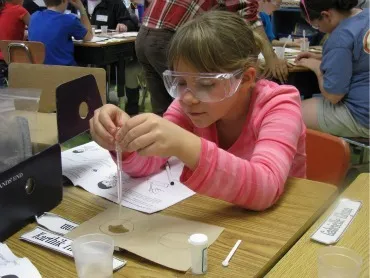Sharing Chemistry with a Local Elementary School
The department's love of chemistry is often shared with the Swarthmore community by students and faculty. The department brought the science of polymers to two classes at the Swarthmore Rutledge School elementary school which is nearby the Swarthmore College campus. Below is one Swarthmore student's account of working with third-graders.
Polymers, polymers everywhere - and even some that drink!
October 19th 2011, a drizzly afternoon at Swarthmore Rutledge School, was punctuated with a visit from two professors - Professors Kathleen Howard and Liliya Yatsunyk - and eight students from Swarthmore's Chemistry Department. The professors and students, all of whom are enrolled in the Honors General Chemistry Seminar (CHEM 010H), engaged a class of third grade students with a hands-on activity, which introduced the basic properties of polymers and the prevalence of polymers in everyday life.
Professor Howard introduced the activity with a few examples of the properties of commonly found polymers, including polyvinyl acetate (PVA) and sodium polyacrylate. The third-graders then divided into five groups, each lead by one or two Swarthmore students, and participated in three hands-on experiments that investigated the properties of polymers in greater detail.
The first experiment involved the water-absorbent tendencies of sodium polyacrylate, dubbed "Super Water-Absorber" in the activity, and how its properties change with the addition of salt. In the second experiment, students grew their own polymer-composed dinosaurs by immersing them in water over the series of a few days. And finally, in the third experiment, students created their own slime by vigorously mixing PVA solution with sodium tetraborate, otherwise known as Borax solution. With the help of the Swarthmore students, the third-graders also answered a series of questions that were designed to help them adopt a scientific approach towards their observations and measurements.
When the experiments were over, Professor Howard concluded the visit with a discussion about the appreciable presence and significance of polymers in our daily lives. All in all, the activity was a success; the children had fun and learned all about the properties and practical importance of these substances. Furthermore, the third-graders were eager to learn and the Swarthmore students eager to teach, and this enthusiasm made the lesson all the more enriching for all of those involved.

Professor Kathleen Howard teaches third-graders from a nearby school all about polymers.

Professor Yatsunyk works with third-graders who seem fascinated by what she is doing.

A third grade student experiments with polymers.

A Swarthmore student helps local third-graders learn about polymers.








